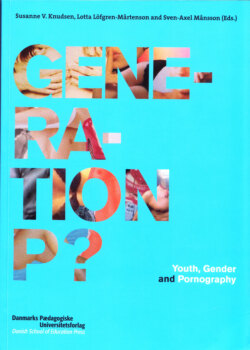Читать книгу Generation P? - Группа авторов - Страница 6
На сайте Литреса книга снята с продажи.
The study of youth, gender and pornography in the Nordic countries
ОглавлениеIt was questions like these that motivated the Nordic Ministers of Equal Opportunities and the Nordic Council of Ministers to perform a major study on youth, gender and pornography in the Nordic countries during 2004-2006. However, the rationale behind the study was also driven by a very clear and distinct political concern that the increasingly one-dimensional representation of masculinity and femininity associated with the mainstreaming of pornography and the sexualisation of public space, would limit the possibilities of young people’s gender identification. This development, it was felt, presents a serious threat to the realization of the ideals of gender equality in the Nordic countries (Sørensen & Knudsen 2006).
The study was hosted by NIKK, Nordic Institute for Women’s Studies and Gender Research and officially aimed at revealing possible connections between teenager’s exposure to pornography and their attitudes towards gender and power by:
gaining insights into the extent of ‘pornofication’, its media basis and the situations in which it appears, with special focus on Nordic teenager’s experiences with and attitudes towards pornography;
analyzing young people’s views of the images and ideals of gender and gender relations depicted in pornography, and their feelings towards these images and ideals;
studying how the increased exposure to pornography relates to the teenagers’ own perceptions of gender, and their ideas, experiences and views with regard to sexuality.
After a call for research plans, eleven researchers from different Nordic countries were chosen and invited to participate in the project during a period of two years (2004-2006). Methodologically, the project was divided into three independent parts consisting of (1) quantitative studies with questionnaires on the Internet, (2) qualitative studies with in-depth interviews with young people, focus groups and case studies and (3) media studies. Primarily, the aim of the quantitative studies was to find out about consumption patterns and attitudes: how often young people use pornography, why they use it and what their attitudes are toward gender representations, performances and bodily images depicted in it. Seldom are young people’s own voices being heard in the debate about their views on and experiences with sex and porn in public space. The intention of the qualitative studies was to remedy this by listening to young people’s talk about pornography. Finally, the purpose of the media studies was to analyze the depiction of gender, sex and pornography in the media, including public service TV, youth Internet sites and free porn Internet sites. The results of the project were published in 2006 by the Nordic Council of Ministers in three separate volumes titled Unge, køn og pornografi i Norden (Youth, gender and pornography in the Nordic countries).1
The NIKK study shows that young people consume pornography in varying degrees, boys more than girls; they are familiar with various genres and appear to be fairly reflective and critical in relation to what they see. On the other hand, it also is evident that the issue of young people’s experiences of pornography and its effects on their perceptions about gender and sexuality is complex and offers no easy answers. This complexity will be further elaborated in this anthology. Furthermore, The NIKK study reveals that there are no significant differences between the Nordic countries. One likely reason is that the discourses in the Nordic countries concerning sexuality are similar, if not identical. Another important factor probably is the globalization of sexuality in the media and on the Internet which gives young people access to the same content, on the same terms, at the same time.
